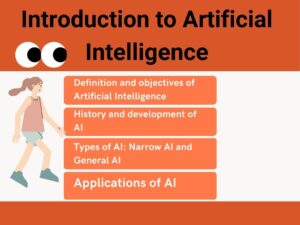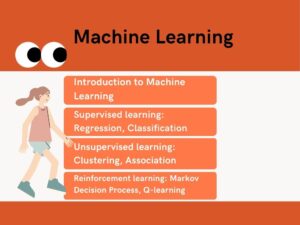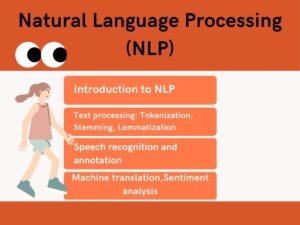Artificial Intelligence and Machine Learning Course Syllabus
Course Overview
This course provides a comprehensive introduction to the principles, techniques, and applications of Artificial Intelligence (AI) and Machine Learning (ML). Students will gain a solid foundation in the mathematical and computational underpinnings of AI, as well as hands-on experience in developing and applying ML models.
Course Objectives
- Understand the fundamental concepts of AI and ML
- Develop a strong foundation in mathematical and statistical methods for AI
- Learn various ML algorithms and their applications
- Gain practical experience in implementing ML models using programming languages and tools
- Explore advanced topics in AI, such as deep learning and natural language processing
Module 1: Introduction to AI and ML

This module provides a foundational understanding of Artificial Intelligence (AI) and Machine Learning (ML). It covers the historical development, key concepts, and differentiation between AI, ML, and related fields.
Key Topics
- Defining AI and ML: Clear distinctions between AI as the broader concept of intelligent agents and ML as a subset focused on learning from data.
- Types of AI: Exploration of weak AI, strong AI, and artificial general intelligence (AGI).
- Historical Perspective: A brief overview of the evolution of AI and ML, including key milestones and breakthroughs.
- AI and ML Applications: Real-world examples from various industries to illustrate the practical impact of these technologies.
- Ethical Considerations: Discussing the ethical implications of AI, such as bias, privacy, and accountability.
Learning Outcomes
Upon completion of this module, students will be able to:
-
Define AI and ML accurately.
-
Differentiate between various types of AI.
-
Understand the historical context of AI and ML.
-
Identify potential applications of AI and ML in different domains.
-
Recognize the ethical challenges associated with AI.
By the end of this module, students will have a solid groundwork to delve deeper into the technical aspects of AI and ML.
Module 2: Mathematical Foundations
This module lays the groundwork for understanding the underlying mathematical principles that power AI and ML algorithms.
Key Topics
- Linear Algebra: The study of vectors, matrices, and their operations. Essential for representing data and performing computations in ML models.
- Probability and Statistics: Understanding probability distributions, statistical inference, and hypothesis testing. Crucial for modeling uncertainty and making informed decisions.
- Calculus: Differential and integral calculus concepts. Used in optimization problems and understanding the behavior of functions.
- Algorithms and Data Structures: Exploring fundamental algorithms and data structures. Important for efficient data manipulation and model training.
Learning Outcomes
Students will be able to:
-
Apply linear algebra concepts to represent and manipulate data.
-
Use probability and statistics to analyze data and make inferences.
-
Utilize calculus for optimization problems in ML.
-
Select appropriate algorithms and data structures for ML tasks.
A strong foundation in these mathematical areas is crucial for success in subsequent modules and in applying ML techniques to real-world problems.
Module 3: Machine Learning Fundamentals

This module introduces the core concepts and techniques of machine learning. It builds upon the mathematical foundation established in Module 2.
Key Topics
- Supervised Learning: Learning from labeled data to make predictions.
- Regression: Predicting continuous numerical values.
- Classification: Predicting categorical labels.
- Unsupervised Learning: Discovering patterns in unlabeled data.
- Clustering: Grouping similar data points.
- Dimensionality Reduction: Reducing the number of features.
- Model Evaluation: Assessing the performance of ML models.
- Metrics: Accuracy, precision, recall, F1-score, etc.
- Cross-validation: Evaluating model generalization.
- Bias-Variance Trade-off: Balancing underfitting and overfitting.
- Overfitting and Underfitting: Understanding these issues and techniques to address them.
Learning Outcomes
Students will be able to:
-
Differentiate between supervised and unsupervised learning.
-
Apply appropriate algorithms for regression and classification problems.
-
Evaluate ML models using relevant metrics.
-
Understand the concept of bias-variance trade-off.
-
Identify and address overfitting and underfitting issues.
This module provides a solid foundation for understanding the practical application of ML algorithms to real-world problems.
Module 4: ML Algorithms
This module delves into specific machine learning algorithms, providing practical implementation and application knowledge.
Key Topics
- Linear Regression: Predicting continuous numerical values using linear relationships.
- Logistic Regression: Predicting categorical outcomes using a logistic function.
- Decision Trees and Random Forests: Creating tree-like models for classification and regression.
- Support Vector Machines (SVMs): Finding optimal hyperplanes to separate data points.
- Naive Bayes: Probabilistic classification based on Bayes’ theorem.
- K-Means Clustering: Grouping data points into clusters based on similarity.
- Hierarchical Clustering: Creating hierarchical clusters based on distance metrics.
Learning Outcomes
Students will be able to:
-
Select appropriate algorithms for different ML tasks.
-
Implement and evaluate these algorithms using programming tools.
-
Understand the strengths and weaknesses of various algorithms.
-
Apply algorithms to real-world datasets and draw insights.
This module provides hands-on experience in building and applying ML models, preparing students for more complex algorithms and projects.
Module 5: Deep Learning
This module delves into the powerful techniques of deep learning, focusing on artificial neural networks.
Key Topics
- Artificial Neural Networks: Understanding the basic structure and function of neurons, layers, and activation functions.
- Backpropagation: Learning how neural networks learn through gradient descent optimization.
- Convolutional Neural Networks (CNNs): Applying deep learning to image and computer vision tasks.
- Recurrent Neural Networks (RNNs): Processing sequential data like text and time series.
- Generative Adversarial Networks (GANs): Generating new data instances similar to training data.
Learning Outcomes
Students will be able to:
-
Build and train various types of neural networks.
-
Apply deep learning to image, text, and other complex data.
-
Understand the architecture and working of CNNs, RNNs, and GANs.
-
Explore advanced topics like transfer learning and fine-tuning.
Deep learning has revolutionized many fields, and this module provides students with the skills to leverage its potential.
Module 6: Natural Language Processing (NLP)

This module focuses on enabling computers to understand, interpret, and generate human language.
Key Topics
- Text Preprocessing: Cleaning and preparing text data for analysis.
- Word Embeddings: Representing words as numerical vectors to capture semantic and syntactic relationships.
- Sentiment Analysis: Determining the sentiment (positive, negative, neutral) of a text.
- Machine Translation: Translating text from one language to another.
- Text Generation: Creating human-like text, such as writing different kinds of creative content.
Learning Outcomes
Students will be able to:
-
Preprocess text data for NLP tasks.
-
Create word embeddings to represent textual information.
-
Build models for sentiment analysis and text classification.
-
Develop machine translation systems.
-
Generate text using advanced NLP techniques.
NLP has a wide range of applications, from chatbots to language-based assistants, and this module provides the foundational knowledge for exploring these areas.
Module 7: AI and ML Applications
This module bridges the gap between theory and practice, showcasing the real-world applications of AI and ML.
Key Topics
- Computer Vision: Teaching computers to understand and interpret visual information.
- Robotics: Developing intelligent robots capable of interacting with the physical world.
- Recommender Systems: Suggesting items or content based on user preferences.
- Natural Language Understanding: Enabling computers to understand and respond to human language.
- Reinforcement Learning: Learning through trial and error, interacting with an environment.
Learning Outcomes
Students will be able to:
-
Apply AI and ML techniques to solve real-world problems.
-
Understand the challenges and opportunities in different application domains.
-
Develop AI-powered systems for various industries.
-
Analyze and evaluate the performance of AI systems in practical settings.
This module provides a platform for students to explore their interests and potential career paths within the AI and ML field.
Course Assessment
Course assessment is designed to evaluate students’ understanding and application of AI and ML concepts.
Common Assessment Methods:
- Assignments and Projects: Practical application of learned concepts through individual or group projects.
- Midterm Exam: Evaluates theoretical knowledge and problem-solving abilities.
- Final Exam: Comprehensive evaluation of overall course understanding.
- Presentations: Demonstrates ability to communicate technical concepts and project outcomes.
Programming Languages and Tools
To effectively implement AI and ML concepts, proficiency in specific programming languages and tools is essential.
Core Languages:
- Python: Widely used due to its simplicity, readability, and extensive libraries for data manipulation, scientific computing, and ML (NumPy, Pandas, Scikit-learn, TensorFlow, PyTorch).
- R: Primarily used for statistical computing and data visualization, popular in academic and research communities.
- MATLAB: Specialized for numerical computing, algorithm development, and simulation, often used in engineering and scientific fields.
Additional Tools:
- Jupyter Notebook: Interactive environment for combining code, visualizations, and explanatory text.
- Git: Version control system for managing code changes and collaboration.
- Cloud Platforms (AWS, GCP, Azure): For deploying and scaling ML models.
Note: The choice of programming languages and tools often depends on the specific project, team preferences, and available resources.
Additional Topics
The depth and breadth of an AI and ML course can vary significantly. The following topics might be included based on the course level and specific focus:
Advanced Topics:
- Reinforcement Learning: Learning through interaction with an environment to maximize rewards.
- Bayesian Networks: Graphical models for representing probabilistic relationships between variables.
- Knowledge Representation and Reasoning: Capturing and utilizing knowledge for intelligent systems.
- Expert Systems: Systems that mimic human expertise in a specific domain.
Specialized Areas:
- AI Ethics and Safety: Addressing ethical implications and safety concerns of AI systems.
- AI for Specific Domains: Exploring applications in healthcare, finance, or other industries.
- AI Hardware and Architecture: Understanding specialized hardware for AI computations (e.g., GPUs, TPUs).
Practical Skills:
-
Big Data Processing: Handling large datasets for AI applications.
-
Cloud Computing for AI: Utilizing cloud platforms for AI development and deployment.
-
MLOps: Integrating ML models into production environments.
Note: These topics can be explored in more depth depending on the course’s focus and student interests.
“Thanks for coming on Appsbubble.com”

